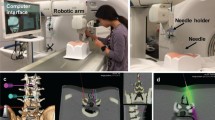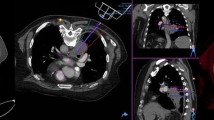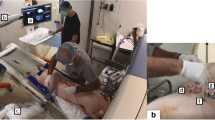Abstract
Introduction
This was a prospective, first-in-human trial to evaluate the feasibility and safety of insertion of biopsy introducer needles with our robot during CT fluoroscopy–guided biopsy in humans.
Materials and methods
Eligible patients were adults with a lesion ≥ 10 mm in an extremity or the trunk requiring pathological diagnosis with CT fluoroscopy–guided biopsy. Patients in whom at-risk structures were located within 10 mm of the scheduled needle tract were excluded. Ten patients (4 females and 6 males; mean [range] age, 72 [52–87] years) with lesions (mean [range] maximum diameter, 28 [14–52] mm) in the kidney (n = 4), lung (n = 3), mediastinum (n = 1), adrenal gland (n = 1), and muscle (n = 1) were enrolled. The biopsy procedure involved robotic insertion of a biopsy introducer needle followed by manual acquisition of specimens using a biopsy needle. The patients were followed up for 14 days. Feasibility was defined as the distance of ≤ 10 mm between needle tip after insertion and the nearest lesion edge on the CT fluoroscopic images. The safety of robotic insertion was evaluated on the basis of machine-related troubles and adverse events according to the Clavien-Dindo classification.
Results
Robotic insertion of the introducer needle was feasible in all patients, enabling pathological diagnosis. There was no machine-related trouble. A total of 11 adverse events occurred in 8 patients, including 10 grade I events and 1 grade IIIa event.
Conclusion
Insertion of biopsy introducer needles with our robot was feasible at several locations in the human body.
Key Points
• Insertion of biopsy introducer needles with our robot during CT fluoroscopy–guided biopsy was feasible at several locations in the human body.



Similar content being viewed by others
Abbreviations
- CT:
-
Computed tomography
- DOF:
-
Degrees of freedom
- SD:
-
Standard deviation
References
Katada K, Kato R, Anno H et al (1996) Guidance with real-time CT fluoroscopy: early clinical experience. Radiology 200:851–856
Froelich JJ, Ishaque N, Regn J, Saar B, Walthers EM, Klose KJ (2002) Guidance of percutaneous pulmonary biopsies with real-time CT fluoroscopy. Eur J Radiol 42:74–79
Gianfelice D, Lepanto L, Perreault P, Chartrand-Lefebvre C, Milette PC (2000) Value of CT fluoroscopy for percutaneous biopsy procedures. J Vasc Interv Radiol 11:879–884
Kirchner J, Kickuth R, Laufer U, Schilling EM, Adams S, Liermann D (2002) CT fluoroscopy assisted puncture of thoracic and abdominal masses: a randomized trial. Clin Radiol 57:188–192
Carlson SK, Bender CE, Classic KL et al (2001) Benefits and safety of CT fluoroscopy in interventional radiologic procedures. Radiology 219:515–520
Silverman SG, Tuncali K, Adams DF, Nawfel RD, Zou KH, Judy PF (1999) CT fluoroscopy-guided abdominal interventions: techniques, results, and radiation exposure. Radiology 212:673–681
Paulson EK, Sheafor DH, Enterline DS, McAdams HP, Yoshizumi TT (2001) CT fluoroscopy-guided interventional procedures: techniques and radiation dose to radiologists. Radiology 220:161–167
Daly B, Krebs TL, Wong-You-Cheong JJ, Wang SS (1999) Percutaneous abdominal and pelvic interventional procedures using CT fluoroscopy guidance. AJR Am J Roentgenol 173:637–644
Matsui Y, Hiraki T, Gobara H et al (2016) Radiation exposure of interventional radiologists during computed tomography fluoroscopy-guided renal cryoablation and lung radiofrequency ablation: direct measurement in a clinical setting. Cardiovasc Intervent Radiol 39:894–901
Kim GR, Hur J, Lee SM et al (2011) CT fluoroscopy-guided lung biopsy versus conventional CT-guided lung biopsy: a prospective controlled study to assess radiation doses and diagnostic performance. Eur Radiol 21:232–239
Teeuwisse WM, Geleijns J, Broerse JJ, Obermann WR, van Persijn van Meerten EL (2001) Patient and staff dose during CT guided biopsy, drainage and coagulation. Br J Radiol 74:720–726
Smakic A, Rathmann N, Kostrzewa M, Schönberg SO, Weiß C, Diehl SJ (2018) Performance of a robotic assistance device in computed tomography-guided percutaneous diagnostic and therapeutic procedures. Cardiovasc Intervent Radiol 41:639–644
Wiewiorski M, Valderrabano V, Kretzschmar M et al (2009) CT-guided robotically-assisted infiltration of foot and ankle joints. Minim Invasive Ther Allied Technol 18:291–296
Groetz S, Wilhelm K, Willinek W, Pieper C, Schild H, Thomas D (2016) A new robotic assistance system for percutaneous CT-guided punctures: initial experience. Minim Invasive Ther Allied Technol 25:79–85
Hiraki T, Kamegawa T, Matsuno T et al (2017) Robotically driven CT-guided needle insertion: preliminary results in phantom and animal experiments. Radiology 285:454–461
Hiraki T, Matsuno T, Kamegawa T et al (2018) Robotic insertion of various ablation needles under computed tomography guidance: accuracy in animal experiments. Eur J Radiol 105:162–167
Hiraki T, Kamegawa T, Matsuno T, Komaki T, Sakurai J, Kanazawa S (2018) Zerobot®: a remote-controlled robot for needle insertion in CT-guided interventional radiology developed at Okayama University. Acta Med Okayama 72:539–546
Dindo D, Demartines N, Clavien PA (2004) Classification of surgical complications: a new proposal with evaluation in a cohort of 6336 patients and results of a survey. Ann Surg 240:205–213
Bricault I, Zemiti N, Jouniaux E et al (2008) Light puncture robot for CT and MRI interventions: designing a new robotic architecture to perform abdominal and thoracic punctures. IEEE Eng Med Biol Mag 27:42–50
Walsh CJ, Hanumara NC, Slocum AH, Shepard JA, Gupta R (2008) A patient-mounted, telerobotic tool for CT-guided percutaneous interventions. J Med Devices 2:011007–011010
Shahriari N, Heerink W, van Katwijk T, Hekman E, Oudkerk M, Misra S (2017) Computed tomography (CT)-compatible remote center of motion needle steering robot: fusing CT images and electromagnetic sensor data. Med Eng Phys 45:71–77
Won HJ, Kim N, Kim GB, Seo JB, Kim H (2017) Validation of a CT-guided intervention robot for biopsy and radiofrequency ablation: experimental study with an abdominal phantom. Diagn Interv Radiol 23:233–237
Ben-David E, Shochat M, Roth I, Nissenbaum I, Sosna J, Goldberg SN (2018) Evaluation of a CT-guided robotic system for precise percutaneous needle insertion. J Vasc Interv Radiol 29:1440–1446
Solomon SB, Patriciu A, Bohlman ME, Kavoussi LR, Stoianovici D (2002) Robotically driven interventions: a method of using CT fluoroscopy without radiation exposure to the physician. Radiology 225:277–282
Cleary K, Watson V, Lindisch D et al (2005) Precision placement of instruments for minimally invasive procedures using a “needle driver” robot. Int J Med Robot 1:40–47
Patriciu A, Awad M, Solomon SB et al (2005) Robotic assisted radio-frequency ablation of liver tumors: randomized patient study. Med Image Comput Comput Assist Interv 8:526–533
Funding
This study has received funding from the Japan Society for the Promotion of Science (JSPS) (18K07677), Promotion of Science and Technology, Okayama Prefecture, Japan, Agency for Medical Research and Development (AMED) (15hk0102014h001, 15hk0102014h002, 15hk0102014h003), JSPS (25461882, 17K10439), Organization for Research Promotion & Collaboration, Okayama University; Japan Radiological Society, and Cannon Medical Systems Corporation.
Author information
Authors and Affiliations
Corresponding author
Ethics declarations
Guarantor
The scientific guarantor of this publication is Takao Hiraki.
Conflict of interest
Drs. Hiraki and Kanazawa declare relationships with the following company: Cannon Medical Systems. Other authors of this manuscript declare no relationships with any companies, whose products or services may be related to the subject matter of the article.
Statistics and biometry
No complex statistical methods were necessary for this paper.
Informed consent
Written informed consent was obtained from all subjects (patients) in this study.
Ethical approval
Institutional Review Board approval was obtained.
Methodology
• prospective
• observational
• performed at one institution
Additional information
Publisher’s note
Springer Nature remains neutral with regard to jurisdictional claims in published maps and institutional affiliations.
Electronic supplementary material
ESM 1
(DOCX 21 kb)
Rights and permissions
About this article
Cite this article
Hiraki, T., Kamegawa, T., Matsuno, T. et al. Robotic needle insertion during computed tomography fluoroscopy–guided biopsy: prospective first-in-human feasibility trial. Eur Radiol 30, 927–933 (2020). https://doi.org/10.1007/s00330-019-06409-z
Received:
Revised:
Accepted:
Published:
Issue Date:
DOI: https://doi.org/10.1007/s00330-019-06409-z




